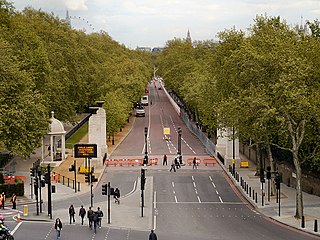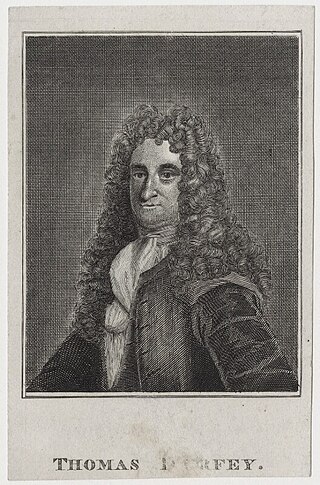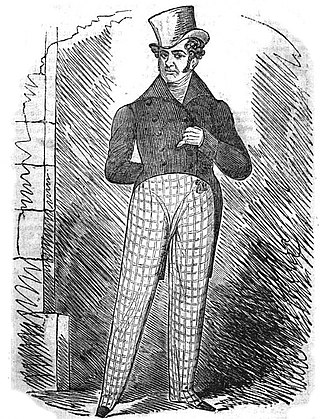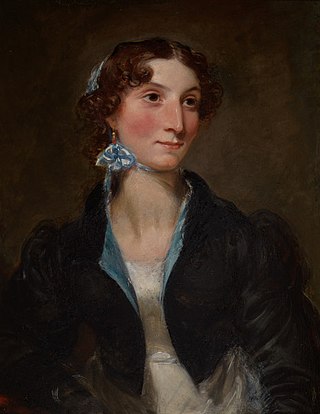Related Research Articles

John Wilmot, 2nd Earl of Rochester was an English poet and courtier of King Charles II's Restoration court, who reacted against the "spiritual authoritarianism" of the Puritan era. Rochester embodied this new era, and he became as well known for his rakish lifestyle as for his poetry, although the two were often interlinked. He died as a result of a sexually transmitted infection at the age of 33.

The School for Scandal is a comedy of manners written by Richard Brinsley Sheridan. It was first performed in London at Drury Lane Theatre on 8 May 1777.

Constitution Hill is a road in the City of Westminster in London. It connects the western end of The Mall with Hyde Park Corner, and is bordered by Buckingham Palace Gardens to the south, and Green Park to the north. At the top of the rise in the roadway at the Corner is the Wellington Arch, near where the road is flanked by the Memorial Gates war memorial.

Barbara Palmer, 1st Duchess of Cleveland, Countess of Castlemaine, was an English royal mistress of the Villiers family and perhaps the most notorious of the many mistresses of King Charles II of England, by whom she had five children, all of them acknowledged and subsequently ennobled. Barbara was the subject of many portraits, in particular by court painter Sir Peter Lely.

Eleanor Gwyn was an English stage actress and celebrity figure of the Restoration period. Praised by Samuel Pepys for her comic performances as one of the first actresses on the English stage, she became best known for being a long-time mistress of King Charles II of England.

Thomas d'Urfey was an English writer and playwright. He wrote plays, songs, jokes, and poems. He was an important innovator and contributor in the evolution of the ballad opera.

The City-Heiress, or, Sir Timothy Treat-all is a play by Aphra Behn first performed in 1682. The play, a Restoration comedy, reflects Behn's own highly Royalist political point of view.

Hortense Mancini, Duchess of Mazarin, was a niece of Cardinal Mazarin, chief minister of France, and a mistress of Charles II, King of England, Scotland, and Ireland. She was the fourth of the five famous Mancini sisters, who, along with two of their female Martinozzi cousins, were known at the court of King Louis XIV of France as the Mazarinettes.

Diomed (1777–1808) was an English Thoroughbred race horse who won the inaugural running of the Epsom Derby in 1780. Sold and imported to Virginia, he was subsequently a successful sire in the United States after the American Revolutionary War.

Blenheim (1927–1958), also known as Blenheim II, was a British Thoroughbred race horse who won The Derby in 1930. As sire, he had a major influence on pedigrees around the world. Blenheim was highly tried, by European standards, as a two-year-old in 1929, winning four of his seven races. In the following season he was beaten in his first two races before recording an upset 18/1 win in the Derby. His racing career was ended by injury soon afterwards, and he was retired to stud, where he became an extremely successful and influential breeding stallion, both in Europe and North America.
The Northern Lass is a Caroline era stage play, a comedy by Richard Brome that premiered onstage in 1629 and was first printed in 1632. A popular hit, and one of his earliest successes, the play provided a foundation for Brome's career as a dramatist.
Sir Carr Scrope, 1st Baronet, versifier and man of fashion in the Restoration court of Charles II of England.

Eleanor was a British Thoroughbred racehorse bred by Charles Bunbury and was the first female horse to win The Derby. Eleanor also won the 1801 Epsom Oaks among many other races before retiring from racing at age eight to become a broodmare for Bunbury. She produced the stallion Muley, which in turn sired the mare Marpessa and the influential stallion Leviathan which was exported to the United States in the early nineteenth century. Through the produce of her daughter Active, Eleanor is present in the pedigrees of 19th-century American Standardbred racehorses.

Big Game (1939–1963) was a British Thoroughbred racehorse and sire. In a career that lasted from April 1941 to October 1942, the colt, who was owned by King George VI, ran nine times and won eight races. He was the best British two-year-old colt of his generation in 1941 when he was unbeaten in five starts. Two further wins the following spring including the 2000 Guineas at Newmarket took his unbeaten run to seven, but he suffered his first defeat when odds-on favourite for the wartime "New Derby". He won his only other race in the Champion Stakes before being retired to stud. Big Game's royal connections and racecourse success made him one of the most popular horses of his time.
Nasram, also known as Nasram II, was an American-bred Thoroughbred race horse and sire who was trained in the United States and France. His early career was undistinguished but in July 1964 he recorded an upset win over Santa Claus in the King George VI and Queen Elizabeth Stakes. Nasram was retired from racing at the end of the season and stood as a breeding stallion in America and Germany.

Benjamin Wrench (1778–1843), was an actor, born in 1778 in London, where his father occupied ‘a lucrative appointment in the Exchequer.’ He seems to have been grandson of Sir Benjamin Wrench, M.D., of Norwich. His father died before he reached his seventh year, and having declined a proffered living and a commission in the army offered by General Tryon, a relative, Wrench adopted the stage as a profession, making his first appearance at Stamford.
Kashmir was an Irish-bred, French-trained Thoroughbred racehorse and sire, best known for winning the classic 2000 Guineas in 1966. Kashmir was one of the leading French-trained two-year-olds of 1965 when he won the Prix Robert Papin and was placed in both the Prix Morny and the Prix de la Forêt. In the following spring he won the Prix Djebel and then defeated twenty-four opponents in the 2000 Guineas. He was beaten in his two subsequent races and was retired to stud where he had considerable success as a sire of winners. When racing in Britain, the horse was known as Kashmir II.
Lambert Simnel (1938–1952) was a British Thoroughbred racehorse and sire, who raced during World War II and was best known for winning the classic 2000 Guineas in 1941. As a two-year-old he won once and finished second in the Dewhurst Stakes In the following spring he won the 2000 Guineas, beating a field which included the subsequent classic winners Owen Tudor and Sun Castle. He was beaten when favourite for the Derby and finished unplaced in the St Leger. He won once as a four-year-old in 1942 before being retired to stud. He stood as a breeding stallion in England and Argentina with limited success before his death in 1952.
Le Ksar was a French Thoroughbred racehorse and sire. Unraced as a two-year-old, he finished second in the Prix Juigné on his racecourse debut and then recorded an emphatic upset victory in the 2000 Guineas. He finished second in the Poule d'Essai des Poulains but ran poorly in the Epsom Derby and never reproduced his best form in subsequent races. He stood as a breeding stallion in England and Argentina but made no impact as a sire of winners.

Charlotte Mardyn was an English actress of Irish descent of the early 19th-century who was rumoured to have been the mistress of Lord Byron.
References
- ↑ "Understanding" (PDF). Archived from the original (PDF) on 2018-07-12.
- ↑ Chapman, Hester W. "Young Days of Old Rowley: The Tragedy of Charles II in the Years 1630-1660".
- ↑ "Poem: Song: Old Rowley the King by Anonymous".
- ↑ i.e. his practice of ennobling his illegitimate sons
- ↑ i.e. his practice of ennobling his mistresses
- ↑ Granger, James (1769). "Biographical History of England from Egbert the Great to the Revolution". pp. 339–340.
- ↑ i.e. siring
- ↑ C.E. Oxberry, ed. (1825). "Oxberry's Dramatic Biography and Histrionic Anecdotes". p. 70.
- ↑ See also Sayings of Charles II
- ↑ "The Edinburgh Budget of Wit and Amusement, Being a Select Collection of Anecdotes, anecdote no.245". 1808. p. 234.
- ↑ Wheatley, Dennis (1933). "Old Rowley: A Private Life Of Charles II". pp. 79–80.